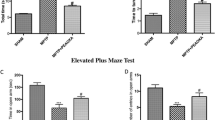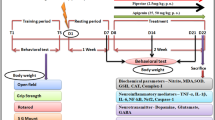Abstract
Neuroinflammation and oxidative stress play critical role in the pathophysiology of neurodegenerative diseases including Parkinson’s disease (PD). Recent reports indicate the beneficial effect of anti-inflammatory drugs in attenuating the progression of PD. Therefore, the present study is aimed to evaluate the possible role of licofelone, a dual COX/LOX-inhibitor against MPTP-induced neurotoxicity in mice. Administration of MPTP (40 mg/kg in divided doses of four injections of 10 mg/kg, i.p. each at 1 h interval) significantly impaired locomotor activity and induced catatonia, oxidative damage (elevated levels of lipid peroxidation, superoxide anion and nitrite, and decreased levels of non-protein thiols) as compared with vehicle-treated animals. Biochemical studies revealed significant alterations in mitochondrial enzyme complex activities (decreased complex-I activity and mitochondrial viability) and increased levels of caspase-3 and NF-κB/p65 as compared to vehicle treated group. Licofelone (2.5, 5 or 10 mg/kg/day, p.o.) treatment for 7 days significantly improved locomotor activity, attenuated the severity of catatonia, oxidative damage and restored mitochondrial enzyme complex activity as compared to MPTP-treated group. Licofelone treatment also attenuated the expression of apoptotic factor (caspase-3) and transcription factor (NF-κB/p65) as compared to MPTP-treated group. The findings of the present study suggest that licofelone (dual inhibitor of COX and LOX) represents a new class of anti-inflammatory agent which may provide a novel therapeutic alternative for the treatment and management of PD.





Similar content being viewed by others
References
Agid Y (1991) Parkinson’s disease: pathophysiology. Lancet 337:1321–1324
Aguirre JA, Leo G, Cueto R, Andbjer B, Naylor A, Medhurst AD et al (2008) The novel cyclooxygenase-2 inhibitor GW637185x protects against l-methyl-4-phenyl-1, 2, 3, 6-tetrahydropyridine toxicity. Neuroreport 19:657–660
Babior BM, Kipner RS, Cerutte JT (1973) Biological defense mechanism. The production by leukocytes of superoxide, a potential bacterial agent. J Clin Invest 52:741–744
Bartels AL, Leenders KL (2007) Neuroinflammation in the pathophysiology of Parkinson’s disease: evidence from animal models to human in vivo studies with [11C]-PK11195 PET. Mov Disord 22:1852–1856
Berman SB, Hastings TG (1999) Dopamine oxidation alters mitochondrial respiration and induces permeability transition in brain mitochondria: implications for Parkinson’s disease. J Neurochem 73:1127–1137
Bias P, Buchner A, Klesser B, Laufer S (2004) The gastrointestinal tolerability of the LOX/COX inhibitor, licofelone, is similar to placebo and superior to naproxen therapy in healthy volunteers: results from randomized, controlled trial. Am J Gastroenterol 99:611–618
Bray MA, Ford-Hutchinson AW, Smith MJ (1981) Leukotriene B4: an inflammatory mediator in vivo. Prostaglandins 22:213–222
Bredt DS, Snyder SH (1990) Isolation of nitric oxide synthetase, a calmodulin-requiring enzyme. Proc Natl Acad Sci USA 87:682–685
Chalimoniuk M, Lukacova N, Marsala J, Langfort J (2006) Alterations of the expression and activity of midbrain nitric oxide synthase and soluble guanylyl cyclase in 1-methyl-4-phenyl-1,2,3,6-tetrahydropyridine-induced parkinsonism in mice. Neuroscience 141:1033–1046
Drechsel DA, Liang LP, Patel M (2007) 1-Methyl-4-phenylpyridinium-induced alterations of glutathione status in immortalized rat dopaminergic neurons. Toxicol Appl Pharmacol 220:341–348
Ellman GL (1959) Tissue sulfhydryl groups. Arch Biochem Biophys 82:70–77
Etminan M, Carleton BC, Samii A (2008) Non-steroidal anti-inflammatory drug use and the risk of Parkinson disease: a retrospective cohort study. J Clin Neurosci 15:576–577
Feng ZH, Wang TG, Li DD, Fung P, Wilson BC, Liu B et al (2002) Cyclooxygenase-2-deficient mice are resistant to 1-methyl-4-phenyl 1,2,3,6-tetrahydropyridine-induced damage of dopaminergic neurons in the substantia nigra. Neurosci Lett 329:354–358
Fiorucci S, Meli R, Bucci M, Cirino G (2001) Dual inhibitors of cyclooxygenase and 5-lipoxygenase. A new avenue in anti-inflammatory therapy. Biochem Pharmacol 62:1433–1438
Gornall AG, Bardawill CJ, David MM (1949) Determination of serum proteins by means of the biuret reaction. J Biol Chem 177:751–766
Gupta A, Dhir A, Kumar A, Kulkarni SK (2009) Protective effect of cyclooxygenase (COX)-inhibitors against drug-induced catatonia and MPTP-induced striatal lesions in rats. Pharmacol Biochem Behav 94:219–226
Gupta A, Dhir A, Kumar A, Kulkarni SK (2010) Effect of preferential cyclooxygenase-2 (COX-2)-inhibitor against 1-methyl-4-phenyl-1, 2, 3, 6-tetrahydropyridine (MPTP)-induced striatal lesions in rats: behavioral, biochemical and histological evidences. Indian J Exp Biol 48:577–585
Halliwell B (1992) Reactive oxygen species and the central nervous system. J Neurochem 59:1609–1623
Hastings TG (1995) Enzymatic oxidation of dopamine: the role of prostaglandin H synthase. J Neurochem 64:919–924
Hirsch EC, Breidert T, Rousselet E, Hunot S, Hartmann A, Michel PP (2003) The role of glial reaction and inflammation in Parkinson’s disease. Ann N Y Acad Sci 991:214–228
Hunter RL, Dragicevic N, Seifert K, Choi DY, Liu M, Kim HC et al (2007) Inflammation induces mitochondrial dysfunction and dopaminergic neurodegeneration in the nigrostriatal system. J Neurochem 100:1375–1386
Kalonia H, Kumar P, Kumar A, Nehru B (2009) Effect of caffeic acid and rofecoxib and their combination against intrastriatal quinolinic acid induced oxidative damage, mitochondrial and histological alterations in rats. Inflammopharmacol 17:211–219
Kim YS, Joh TH (2006) Microglia, major player in the brain inflammation: their roles in the pathogenesis of Parkinson’s disease. Exp Mol Med 38:333–347
King TE, Howard RL (1967) Preparations and properties of soluble NADH dehydrogenases from cardiac muscle. Methods Enzymol 10:275–284
Knott C, Stern G, Wilkin GP (2000) Inflammatory regulators in Parkinson’s disease: iNOS, lipocortin-1, and cyclooxygenases-1 and -2. Mol Cell Neurosci 16:724–739
Kulkarni SK, Singh VP (2007) Licofelone—a novel analgesic and anti-inflammatory agent. Curr Top Med Chem 7:251–263
Laufer S, Tries S, Augustin J, Dannhardt G (1994) Pharmacological profile of a new pyrrolizine derivative inhibiting the enzymes cyclo-oxygenase and 5-lipoxygenase. Arzneimittelforschung 44:629–636
Lewis RA, Austen KF, Soberman RJ (1990) Leukotrienes and other products of the 5-lipoxygenase pathway. Biochemistry and relation to pathobiology in human diseases. N Engl J Med 323:645–655
Li Z, Choi DY, Shin EJ, Hunter RL, Jin CH, Wie MB et al (2008) Phenidone protects the nigral dopaminergic neurons from LPS-induced neurotoxicity. Neurosci Lett 445:1–6
Martel-Pelletier J, Lajeunesse D, Reboul P, Pelletier JP (2003) Therapeutic role of dual inhibitors of 5-LOX and COX, selective and non-selective non-steroidal anti-inflammatory drugs. Ann Rheum Dis 62:501–509
Mosley RL, Benner EJ, Kadiu I, Thomas M, Boska MD, Hasan K et al (2006) Neuroinflammation, oxidative stress and the pathogenesis of Parkinson’s disease. Clin Neurosci Res 6:261–281
Mosmann T (1983) Rapid colorimetric assay for cellular growth survival: application to proliferation and cytotoxicity assays. J Immunol Methods 65:55–63
Ohkawa H, Ohishi N, Yagi K (1979) Assay for lipid peroxides in animal tissues by thiobarbituric acid reaction. Anal Biochem 95:351–358
Przedborski S, Jackson-Lewis V, Yokoyama R, Shibata T, Dawson VL, Dawson TM (1996) Role of neuronal nitric oxide in 1-methyl-4-phenyl-1,2,3,6-tetrahydropyridine (MPTP)-induced dopaminergic neurotoxicity. Proc Natl Acad Sci USA 93:4565–4571
Przybyłkowski A, Kurkowska-Jastrzebska I, Joniec I, Ciesielska A, Członkowska A (2004) Cyclooxygenases mRNA and protein expression in striata in the experimental mouse model of Parkinson’s disease induced by 1-methyl-4-phenyl-1,2,3,6-tetrahydropyridine administration to mouse. Brain Res 1019:144–151
Raghavendra V, Agrewala JN, Kulkarni SK (2000) Melatonin reversal of lipopolysaccharide-induced thermal and behavioral hyperalgesia in mice. Eur J Pharmacol 395:15–21
Rainsford KD (2007) Anti-inflammatory drugs in the 21st century. Subcell Biochem 42:3–27
Singh A, Kulkarni SK (2002) Role of adenosine in drug-induced catatonia. Indian J Exp Biol 40:882–888
Singh VP, Patil CS, Kulkarni SK (2005) Effect of licofelone against NSAIDs-induced gastrointestinal ulceration and inflammation. Indian J Exp Biol 43:247–253
Singh VP, Patil CS, Kulkarni SK (2006) Anti-inflammatory effect of licofelone against various inflammatory challenges. Fundam Clin Pharmacol 20:65–71
Slivka A, Cohen G (1985) Hydroxyl radical attack on dopamine. J Biol Chem 260:15466–15472
Smeyne RJ, Jackson-Lewis V (2005) The MPTP model of Parkinson’s disease. Brain Res Mol Brain Res 134:57–66
Spina MB, Cohen G (1989) Dopamine turnover and glutathione oxidation: implications for Parkinson disease. Proc Natl Acad Sci USA 86:1398–1400
Sriram K, Miller DB, O’Callaghan P (2006) Minocycline attenuates microglial activation but fails to mitigate striatal dopaminergic neurotoxicity: role of tumor necrosis factor-alpha. J Neurochem 96:706–718
Teismann P, Tieu K, Choi DK, Wu DC, Naini A, Hunot S, Vila M, Jackson-Lewis V, Przedborski S (2003) Cyclooxygenase-2 is instrumental in Parkinson’s disease neurodegeneration. Proc Natl Acad Sci USA 100:5473–5478
Theodore S, Cao S, McLean PJ, Standaert DG (2008) Targeted overexpression of human alphasynuclein triggers microglial activation and an adaptive immune response in a mouse model of Parkinson disease. J Neuropathol Exp Neurol 67:1149–1158
Tipton KF, Singer TP (1993) Advances in our understanding of the mechanisms of the neurotoxicity of MPTP and related compounds. J Neurochem 61:1191–1206
Tries S, Laufer S (2001) The pharmacological profile of ML 3000: a new pyrrolizine derivative inhibiting the enzymes cyclooxygenase and 5-lipoxygenase. Inflammopharmacology 9:113–124
Tries S, Neupert W, Laufer S (2002) The mechanism of action of the new anti-inflammatory compound ML3000: inhibition of 5-LOX and COX-1/2. Inflamm Res 51:135–143
Vila M, Przedborski S (2003) Targeting programmed cell death in neurodegenerative diseases. Nat Rev Neurosci 4:365–375
Vila M, Ramonet D, Perier C (2008) Mitochondrial alterations in Parkinson’s disease: new clues. J Neurochem 107:317–328
Wahner AD, Bronstein JM, Bordelon YM, Ritz B (2007) Nonsteroidal anti-inflammatory drugs may protect against Parkinson disease. Neurology 69:1836–1842
Yokoyama H, Kuroiwa H, Yano R, Araki T (2008) Targeting reactive oxygen species, reactive nitrogen species and inflammation in MPTP neurotoxicity and Parkinson’s disease. Neurol Sci 29:293–301
Acknowledgments
The study is supported by the research grant of Council of Scientific and Industrial Research (CSIR), New Delhi and Amit Gupta is a Senior Research Fellow under the project.
Author information
Authors and Affiliations
Corresponding author
Rights and permissions
About this article
Cite this article
Gupta, A., Kumar, A. & Kulkarni, S.K. Licofelone attenuates MPTP-induced neuronal toxicity: behavioral, biochemical and cellular evidence. Inflammopharmacol 18, 223–232 (2010). https://doi.org/10.1007/s10787-010-0052-6
Received:
Accepted:
Published:
Issue Date:
DOI: https://doi.org/10.1007/s10787-010-0052-6




